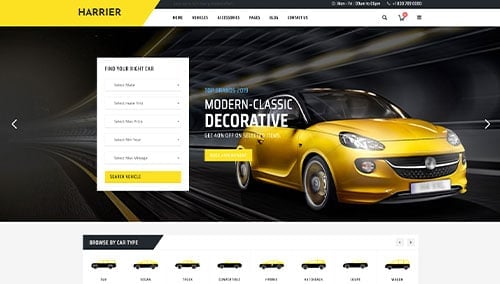Auto dealer websites have become increasingly important in today’s digital age, as consumers are more likely to research and purchase vehicles online. However, with so many options and features available, it can be difficult for auto dealerships to create an effective website that stands out from the competition. That’s why our team of experienced web designers has researched and analyzed hundreds of auto dealer websites to compile a list of the top 38 sites.
Our rankings are based on factors such as design, functionality, creativity, user experience, and more. We tried to find a variety of examples, from small to large auto dealerships that offered new and used vehicles.
By exploring these websites, auto dealers can gain inspiration and insights for their own site. To ensure your car website is helpful for visitors, it’s important to have clear and detailed information about your inventory, user-friendly search and filter options, easy navigation on both desktop and mobile devices, and engaging visuals that showcase your vehicles.
For web design examples across other business sectors, check our top rated websites article!
Top Auto Dealer Website Designs
- 1. Illinois Motor
- 2. DriveTime
- 3. Easterns Automotive Group
- 4. Dorsch Ford
- 5. Drive Straub
- 6. Modern Auto
- 7. Matthews Motors
- 8. Bumble Auto
- 9. AutoMaxx
- 10. Used Cars Minnesota
- 11. Palmetto Cars of Columbia
- 12. CarHop
- 13. 77 Auto
- 14. Ray Catena of Lexus
- 15. Fairless Motors
- 16. Echopark Automotive
- 17. Sam Leman Auto Group
- 18. Toyota
- 19. Boyle Auto Sales
- 20. Chesrown Auto
- 21. Queens Auto Mall
- 22. Chevrolet
- 23. Brian Bemis Toyota of Dekalb
- 24. Infiniti
- 25. Rolls-Royce
- 26. Byers Auto
- 27. SEGREX
- 28. Virginia Auto Trader Company
- 29. Anderson Lincoln
- 30. Ricart Automotive
- 31. Regency Toyota
- 32. Land Rover Tampa
- 33. Volvo Cars Manhattan
- 34. Pierre Ford
- 35. Adamson Motors
- 36. Lexus of Las Vegas
- 37. CarGurus
- 38. Murray Motors
1. Illinois Motor
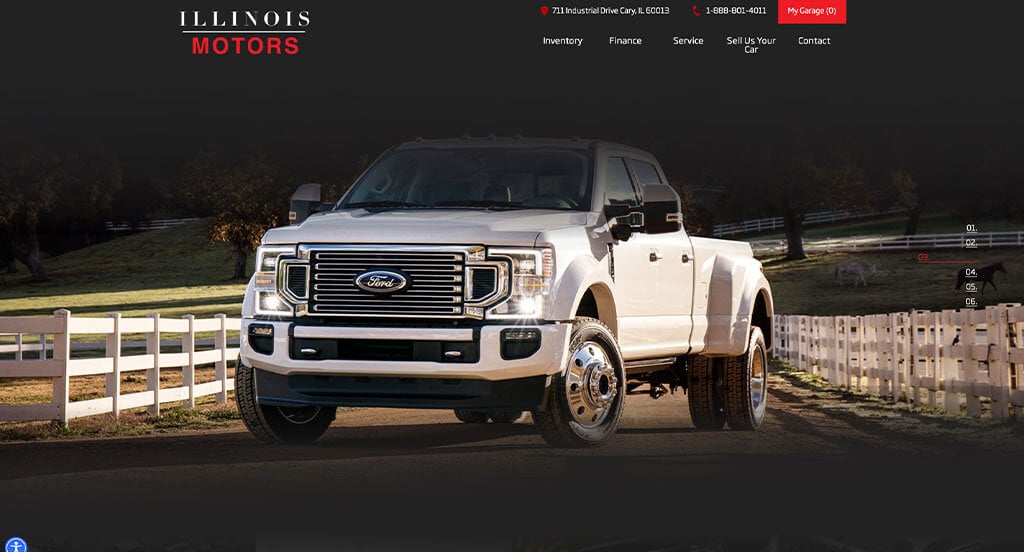
This is a good example of an auto dealer website design for someone who is looking for a professional layout for their next site. Our web designers thought this website was a good design idea for auto dealers because of their high-quality visuals. Another thoughtful quality in this custom auto dealer site was their inclusion of social media. From a marketing perspective, we liked the way they utilized simple contact information. Give some thought to the one-of-a-kind design of this auto dealer website when developing your next website.
2. DriveTime
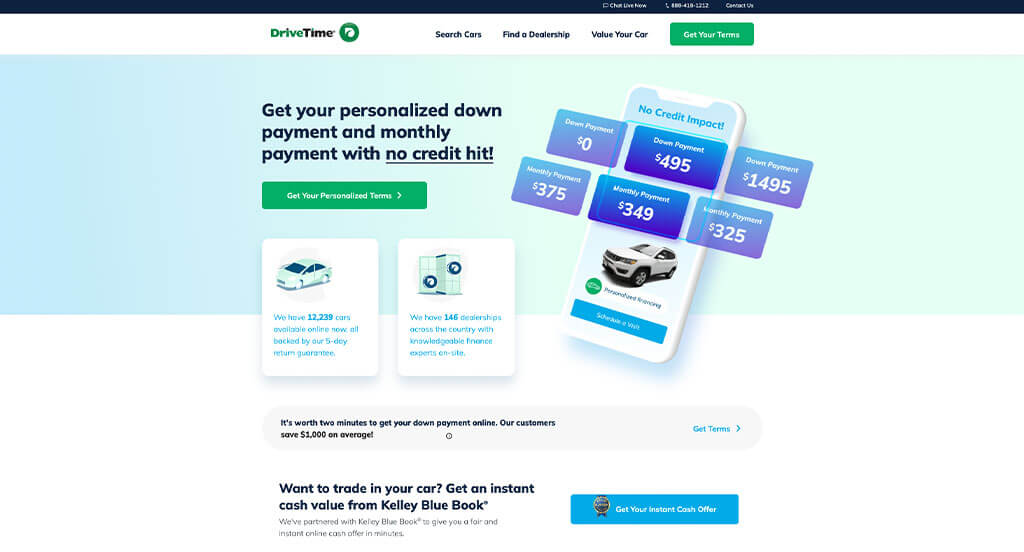
This is a great web design example for auto dealers looking for a professional website design. After scrolling past the navigation of this auto dealer site, you’ll immediately notice the template that was free of distractions. The bold font for the titles was refreshing for a professional website. They clearly had internet marketing in mind when designing the use of buttons throughout their website. Be sure to consider the unique design of this auto dealer website when building your next website.
3. Easterns Automotive Group
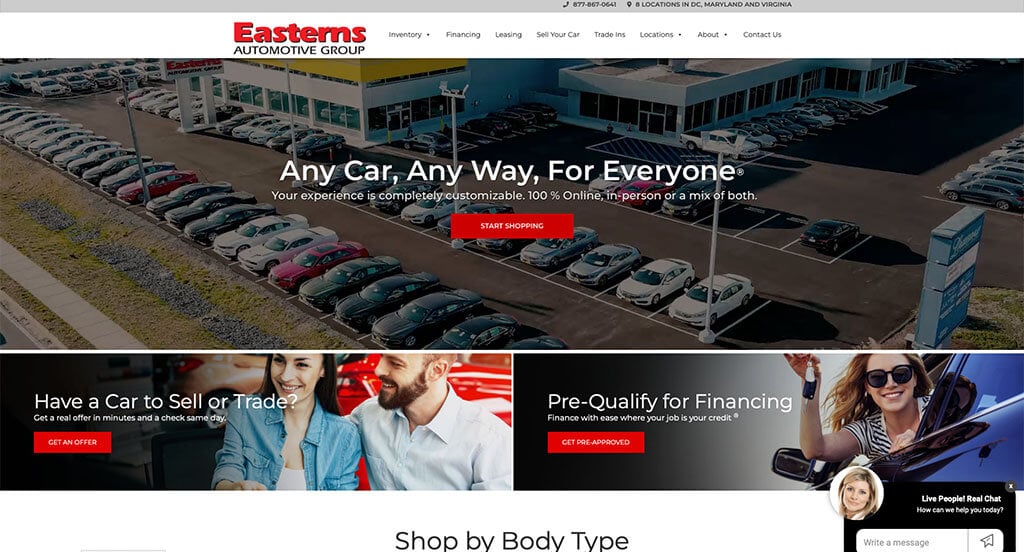
For an auto dealer website, they did a great job utilizing the black, white and red colors used throughout their site. After scrolling past the navigation of this auto dealer site, you’ll notice their use of small graphics throughout their pages. The ability to shop for cars by body type was another reason why we included this website in our list of the best website layouts for auto dealer sites. Easterns Automotive Group clearly had a focus on conversions when building the chat to ask questions directly to their employees. For auto dealers looking for examples for their next website layout, this example will for sure be one to take a look at.
4. Dorsch Ford
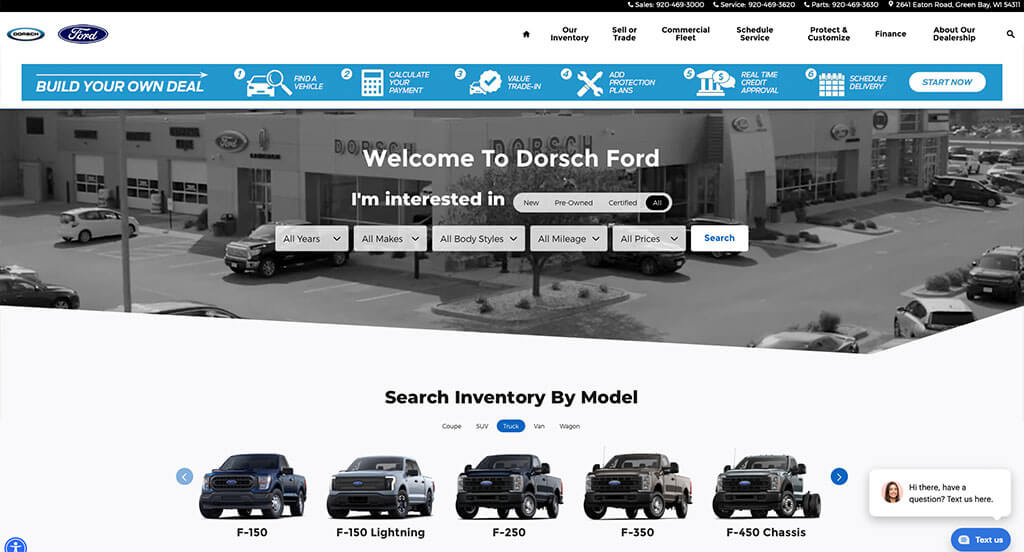
We appreciated how this auto dealer site used the colors of black, white and blue to create an attractive website layout. We thought this website was a good example for auto dealer because of their short and to the point paragraphs. The template that had a good balance of white space was another feature in this custom auto dealer website we enjoyed. Dorsch Ford clearly had a focus on website accessibility when creating the domain for their website that matches the company’s name. Any website designer mocking up websites for auto dealers will want to consider checking this website out.
5. Drive Straub
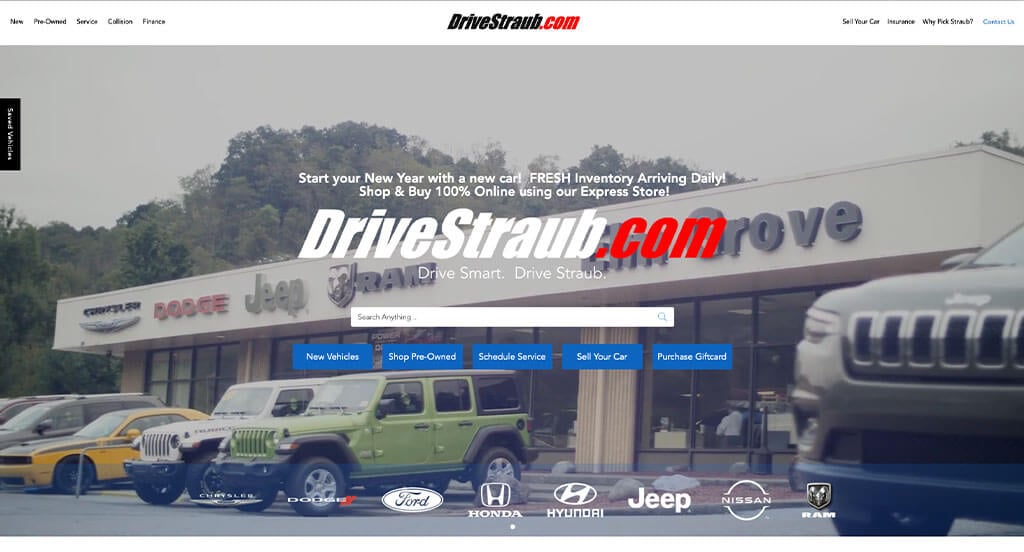
This is a good example of a web design for auto dealers who are looking for a custom layout. The automatically playing video was likely the most impactful feature in the homepage of Drive Straub. The ability to apply filters when searching for vehicles was refreshing for a custom site. Their easily accessed search bar helped make this one of the best auto dealer websites we looked at. If you are looking for template ideas for your next auto dealer site, give some thought to this one.
6. Modern Auto
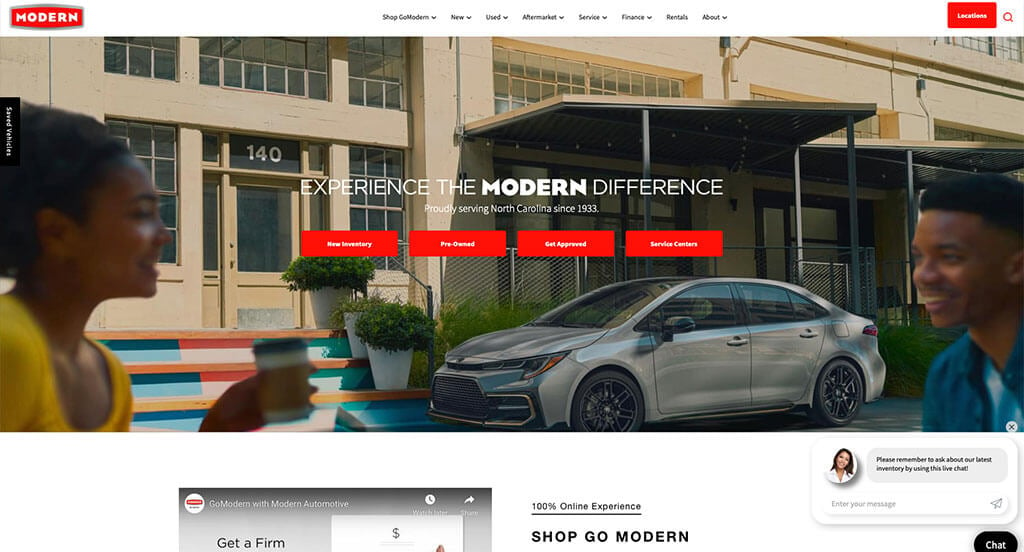
This is a good example of a website for an auto dealer who is looking for custom web design layout ideas. Of all the professional auto dealer websites we reviewed, one of the features in this custom website we liked was their brightly colored buttons. Another design quality in this professional auto dealer site was the professional text. They had conversions in mind when building the navigation bar with organized sections for their website. Be sure to consider the great design of this auto dealer website when developing your next website.
7. Matthews Motors
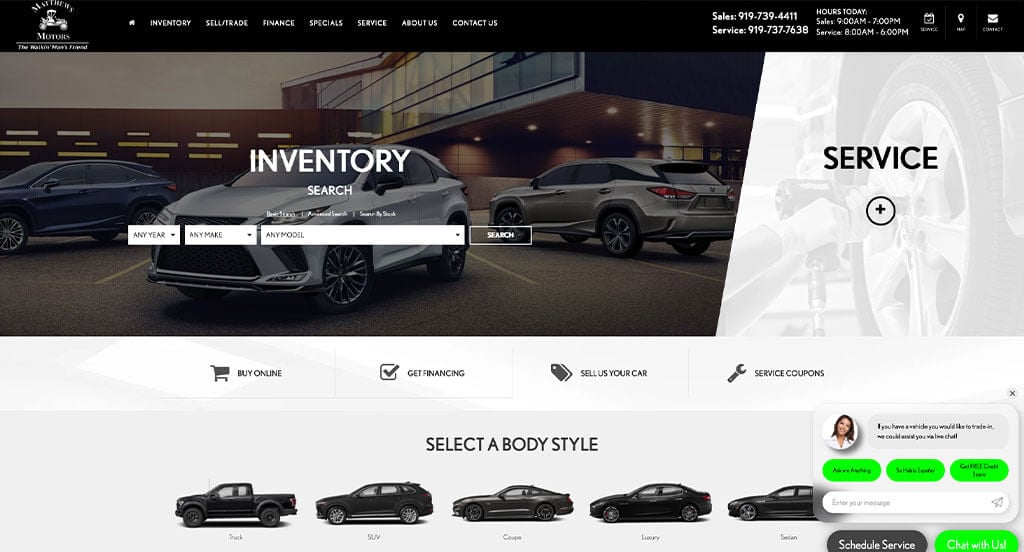
This is a great website design example for auto dealers who are looking for inspiration for a custom look and feel for their next site. The layout of this auto dealer website was thoughtful because of their section to type in your car model to see trade in rates. Another thoughtful quality in this custom auto dealer site we liked was while looking at vehicles, you can reserve test drives. Matthew Motors had internet marketing in mind when building the search bar for their website. There was no shortage of reasons to include this website in our list of websites for auto dealers to consider when designing their next website.
8. Bumble Auto
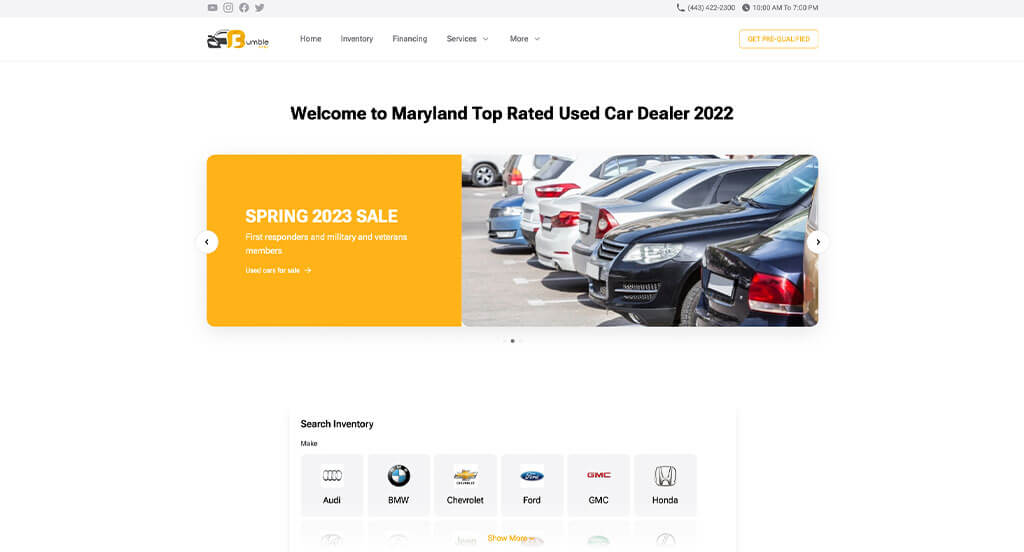
Bumble Auto has a great looking website that uses a white, black, gray and yellow color scheme. The creative logo design was definitely the most impactful feature in the homepage of this website. The ability to heart vehicles was a nice touch for a custom auto dealer site. They clearly had a focus on internet marketing when designing the filters to apply when searching for vehicles within their website. What a great website to review when designing your next website!
9. AutoMaxx
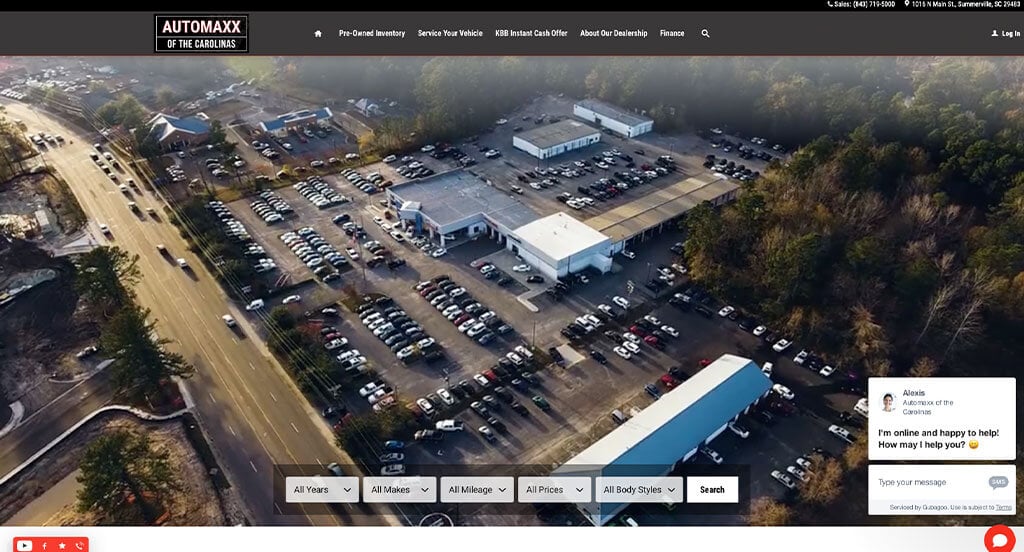
This is a good example of an auto dealer website design to check out when looking for a professional website layout idea. After scrolling past the header of this auto dealer site, you’ll notice their featured vehicle section. The short and to the point paragraphs were definitely refreshing for a unique auto dealer site. AutoMaxx clearly had a focus on internet marketing when designing the simple navigation for their website. For auto dealers looking for examples for their next website layout, this example will for sure be one to consider.
10. Used Cars Minnesota
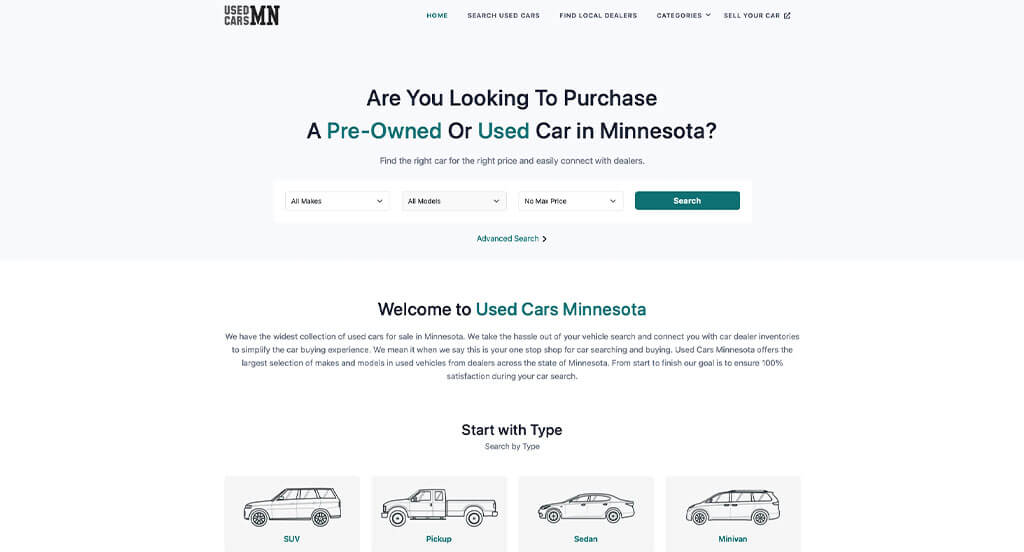
This is a good example of a website design for auto dealers who are looking for a professional look and feel for their next site. Of all the custom auto dealer websites we reviewed, one of the features in this custom website we liked was their layout that was easy to follow. The ability to search with a general filter of make, model and max price within this website helped it make it into our list of the best website ideas for auto dealers. Used Cars Minnesota had website accessibility in mind when building the domain for their website that matches the company’s name. Give some thought to the unique design of this auto dealer website when developing your next custom website.
11. Palmetto Cars of Columbia
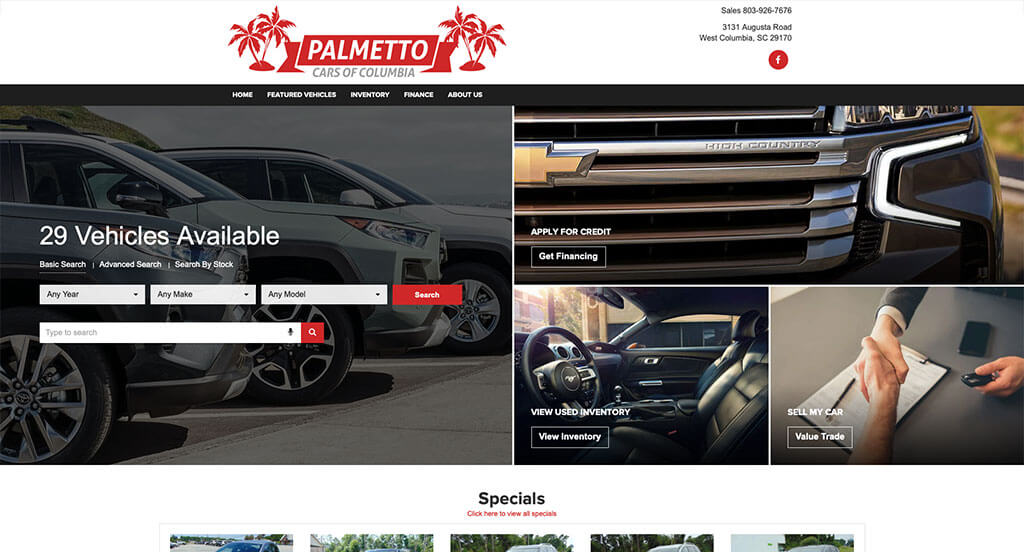
This is a great website design example for an auto dealer looking to pull inspiration for a custom website. After scrolling past the header of this auto dealer website, you’ll immediately notice their high-quality imagery. Another thoughtful feature in this custom auto dealer website was their professional font. Palmetto Cars of Columbia had internet marketing in mind when creating the good mix of images, white space and text in their website. With so many good reasons to consider this auto dealer website, it’s obvious why we included it in this list of the best websites!
12. CarHop
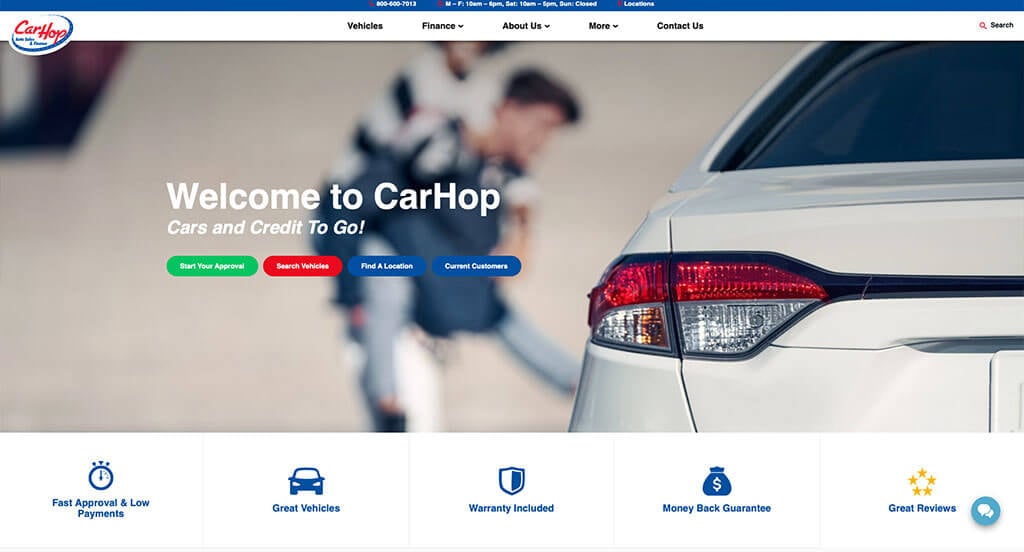
This is a great auto dealer web design example for anyone looking for a professional look and feel for their next custom site. We liked the use of typography in this custom auto dealer website. As you scroll through the homepage, one of the qualities you’ll notice right away is the small icons used throughout the pages of this site. This creative auto dealer site also does a good job with their map showing their locations. They clearly had a focus on website usability when building the navigation bar with organized categories for their website. Another amazing website to add to this list!
13. 77 Auto
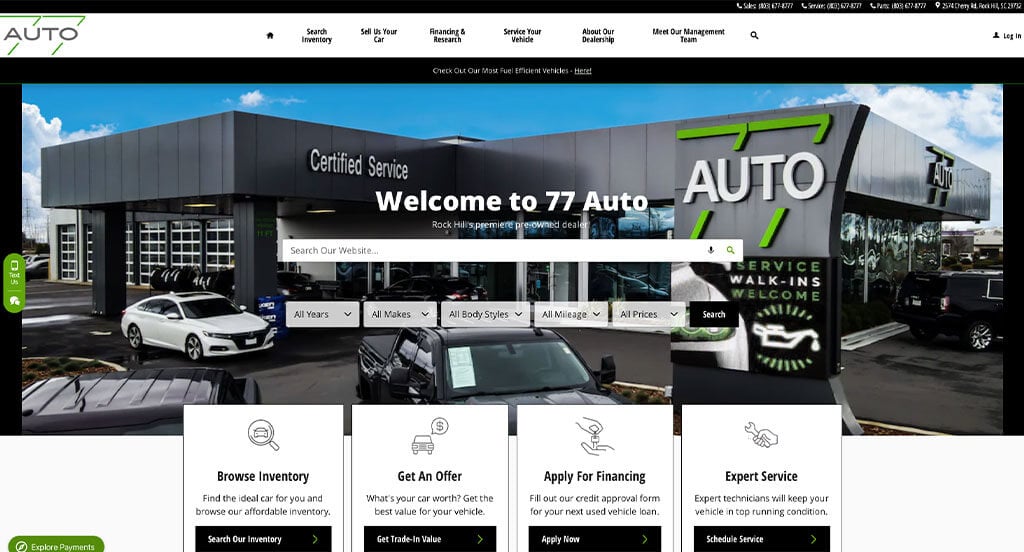
For an auto dealer website, they did a great job utilizing the white, green and black colors throughout their site. One of the homepage features of 77 Auto we noticed was their creative logo design because that isn’t something you find on most auto dealer websites. The layout that was aesthetically pleasing was a good choice for a professional website. 77 Auto had website marketing in mind when creating the clearly labeled menu for their website. There was no shortage of reasons to include this website in our list of websites for auto dealer to consider when designing their next website.
14. Ray Catena of Lexus
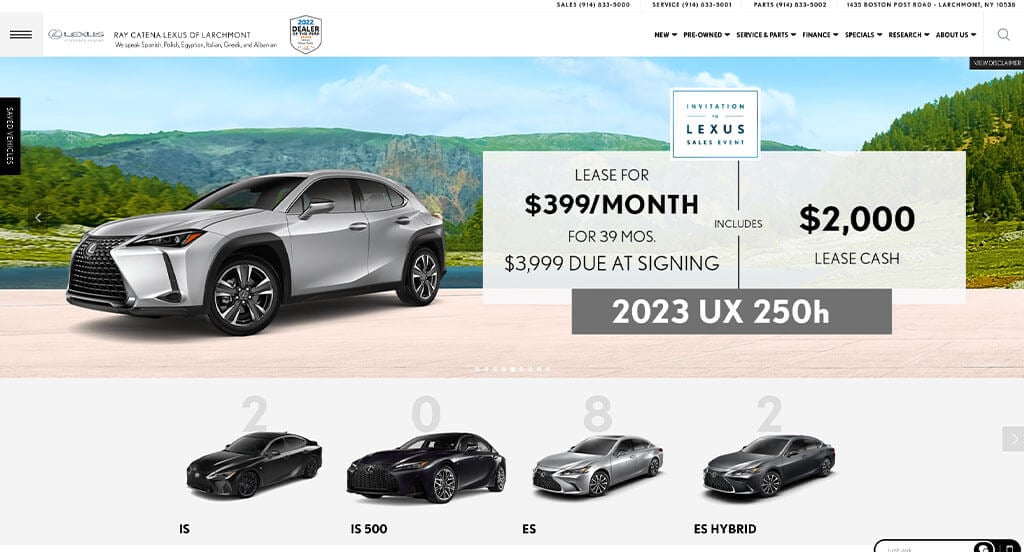
This is a good example of a website design for auto dealers who are looking for a professional website. One of the homepage features of Ray Catena of Lexus we noticed was their stunning imagery. The customer review section was definitely refreshing for a custom website. Ray Catena of Lexus clearly had a focus on internet marketing when creating the research page for their website. You won’t be disappointed after reviewing this website for design ideas for your next website!
15. Fairless Motors
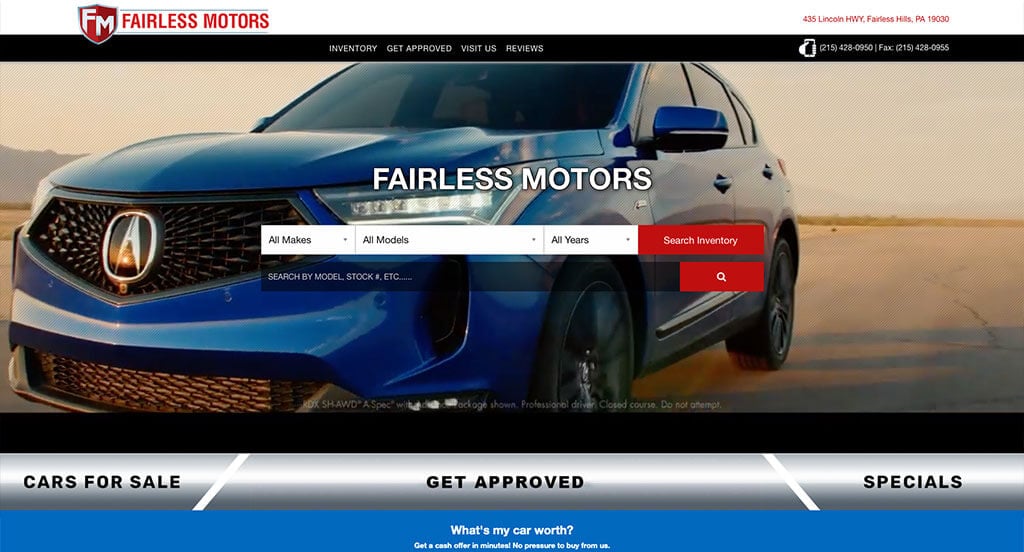
We liked how this auto dealer site combined the colors of black, red and white to create an attractive website layout. Of all the auto dealer websites we reviewed, one of the features in this custom website we liked was their simple navigation. The opportunity to shop by make was a nice touch for a custom site. They had conversions in mind when designing the “HOT DEALS” page for their website. Any website designer mocking up websites for auto dealers will want to consider checking this website out.
16. Echopark Automotive
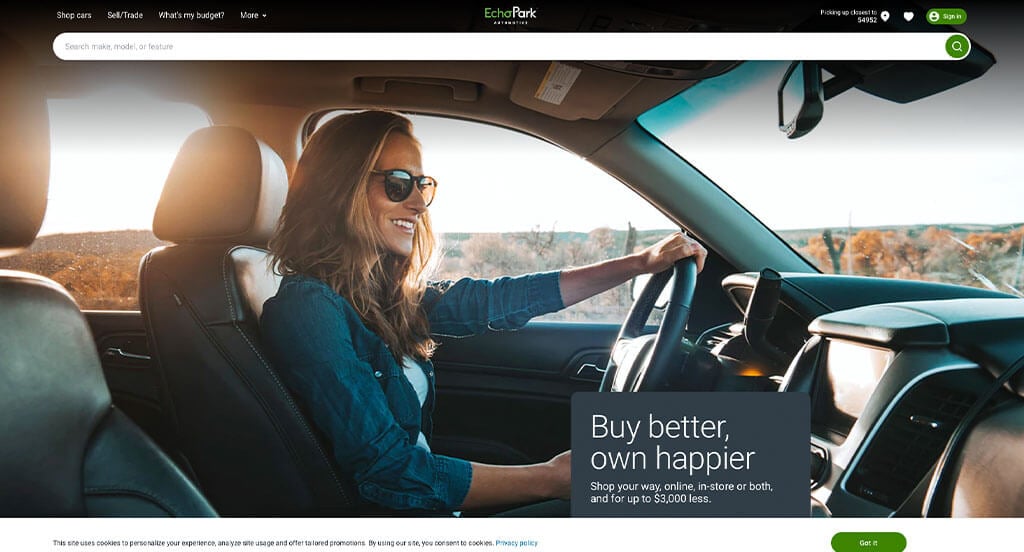
This is a great website design example for an auto dealer company looking to pull inspiration for their next custom website. As you scroll through the homepage of the website, one of the design qualities we liked was the ability to heart vehicles. Another thoughtful quality in this clean auto dealer website we liked was their bold lettering for vehicle prices. They clearly had a focus on website accessibility when building the 190-point vehicle inspection explanation for their website. What a great website to review when building out your next website!
17. Sam Leman Auto Group
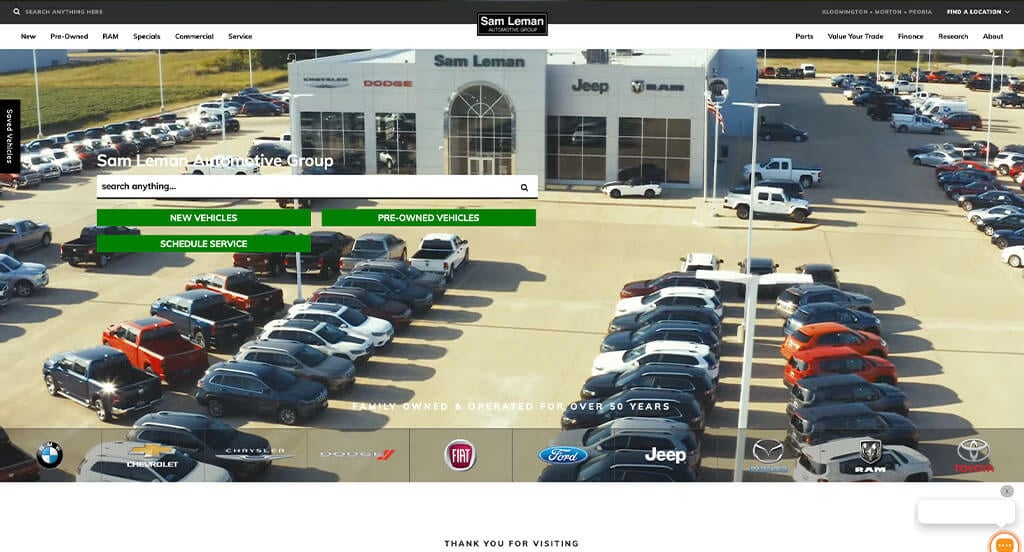
This is a great example for auto dealers who are looking for a professional website layout. After scrolling past the navigation of this auto dealer website, you’ll notice the relaxing color choice. The inclusion of a search bar was refreshing for a custom site. Sam Leman Auto Group clearly had digital marketing in mind when building the simple navigation for their website. Don’t skip past this website when considering design ideas for your next auto dealer website!
18. Toyota
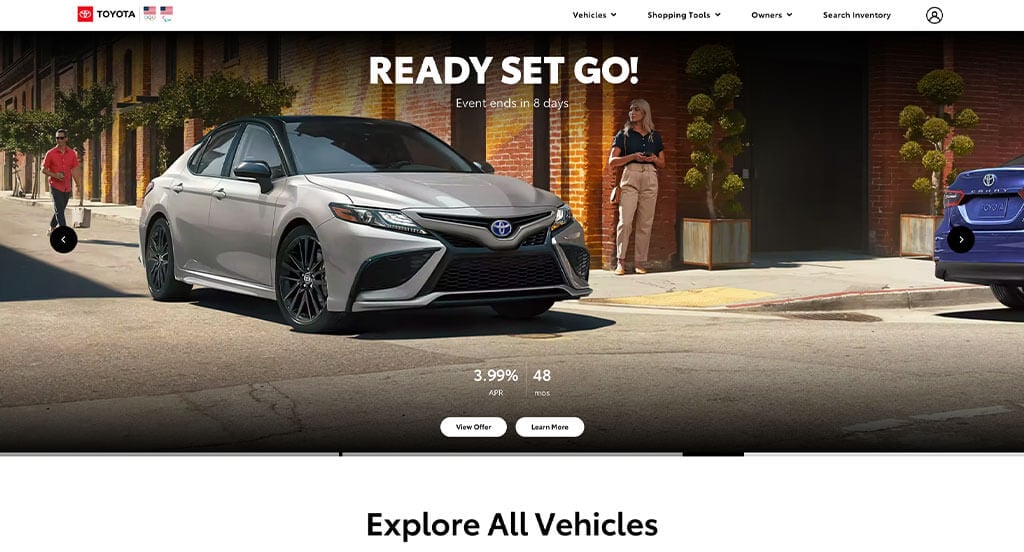
This is a great auto dealer web design example for someone who is looking for a professional layout. After scrolling past the navigation of this auto dealer site, you’ll notice their automatically playing video. The layout with a good balance of white space was a unique choice for a custom auto dealer site. Toyota had digital marketing in mind when building the domain for their website that matches their company’s name. Be sure to consider the one-of-a-kind design of this auto dealer website when developing your next custom website.
19. Boyle Auto Sales
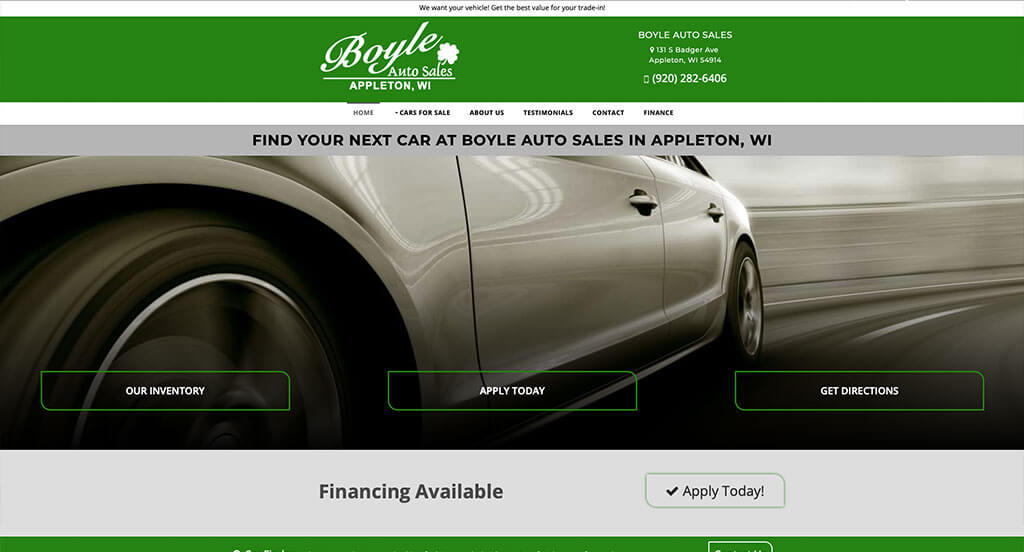
This is a great web design example for auto dealers looking for a professional layout for their next site. The look and feel of the homepage of this auto dealer website caught our attention because of their stunning color scheme. Their use of buttons leading to another section within their site was another design quality in this custom auto dealer site we enjoyed. Boyle Auto Sales clearly had website usability in mind when designing the clearly labeled products for their website. If you are looking for template options for your next auto dealer site, be sure to check this one out.
20. Chesrown Auto
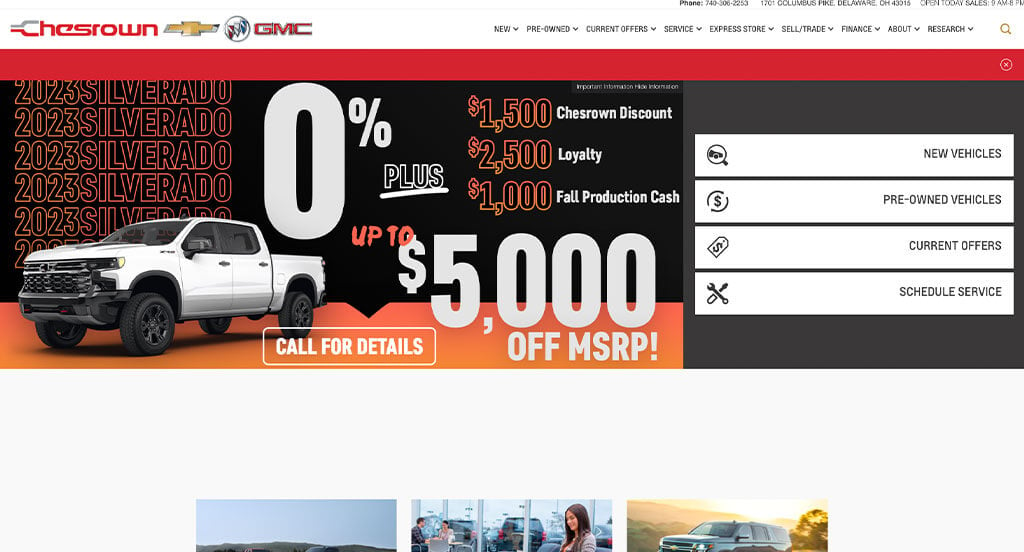
This is a good example of a website for an auto dealer looking for custom web design layout ideas. The slideshow of images was likely the most impactful feature in the homepage of Chesrown Auto. Their use of a chat to talk to an employee was another reason why we included this website in our list of the best website layouts for auto dealers. From a marketing perspective, we liked the way this auto dealer website utilized interesting graphics. Give some thought to the creative design of this auto dealer website when building out your next website.
21. Queens Auto Mall
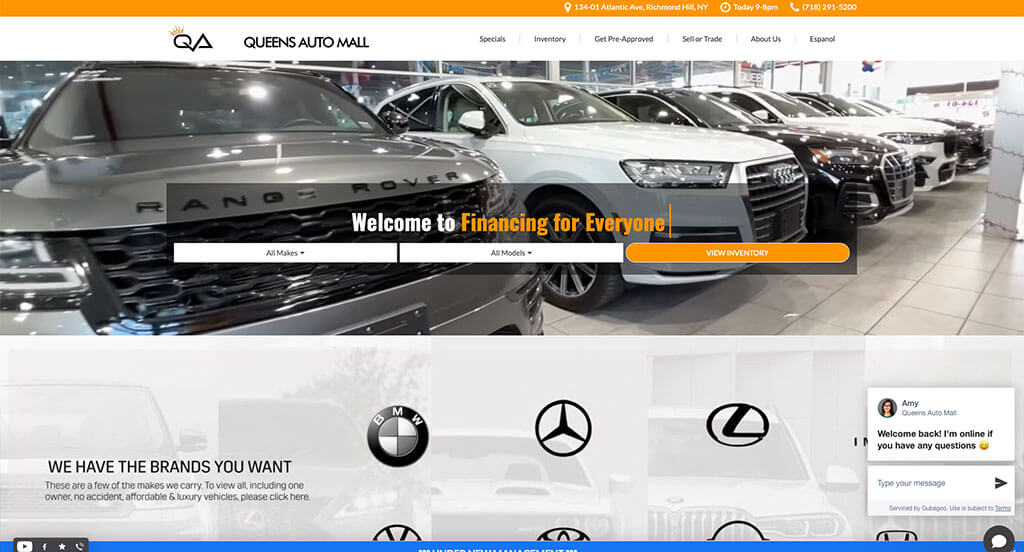
This is a good example of an auto dealer website design to check out when looking for a professional website layout idea. The creative logo design was probably the most impactful feature in the homepage of Queens Auto Mall. The orange accent was a unique choice for a professional auto dealer website. Queens Auto Mall clearly had website usability in mind when creating the simple contact information for their website. Don’t forget to check this website out while looking through our list of the best auto dealer websites!
22. Chevrolet
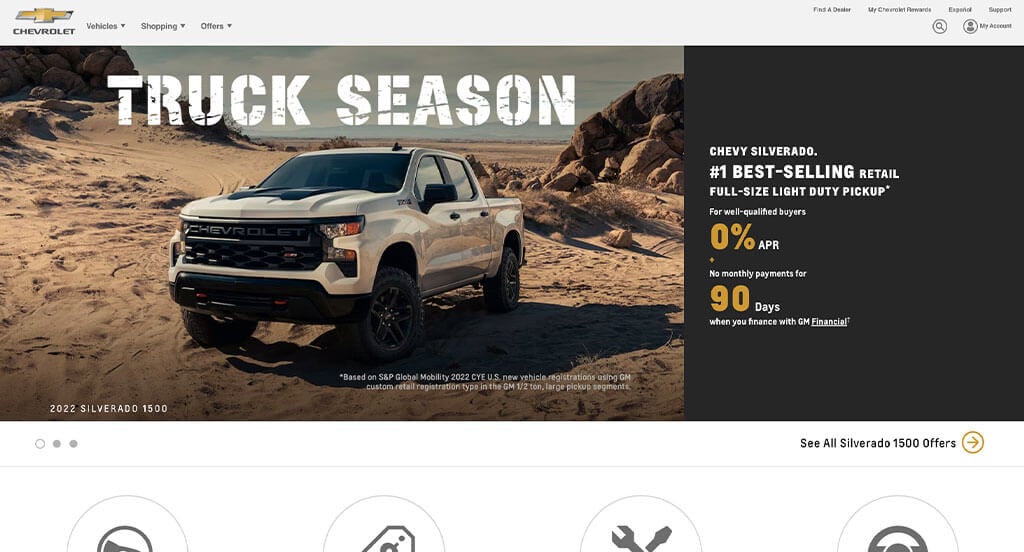
This is a good example of a website design for auto dealers looking for a professional look and feel for their next custom site. The small graphics used throughout the page was definitely the most impactful feature in the homepage of this website. The template with a good balance of white space was refreshing for a professional auto dealer website. They had website marketing in mind when designing the domain for their website that matches their company’s name. These were just a few of the numerous qualities in this website we had to consider when putting together this list of top websites for auto dealers.
23. Brian Bemis Toyota of Dekalb
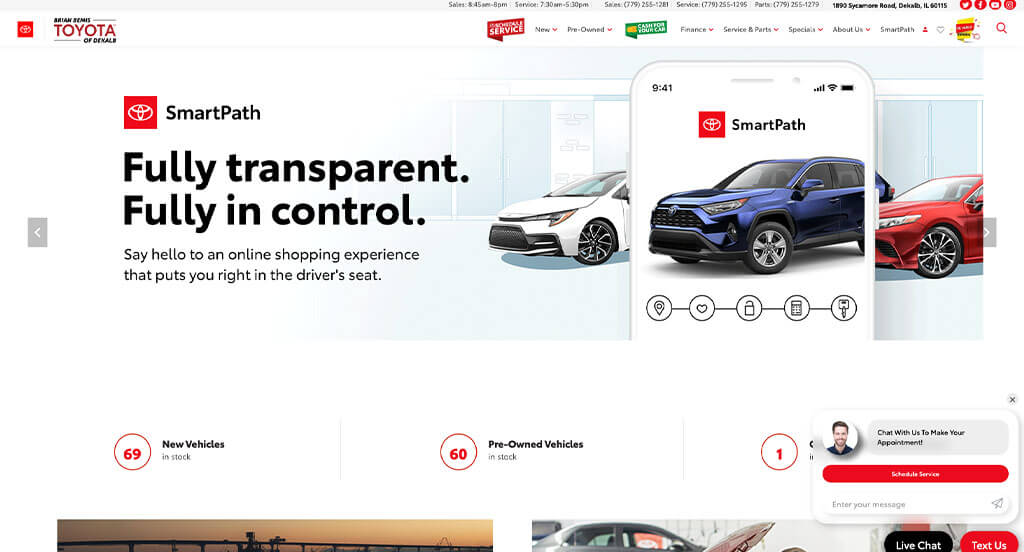
This is a good website example of a website design for auto dealers who are looking for a custom look and feel for their next site. The professional fonts were definitely the most impactful quality in the homepage of Brian Bemis Toyota of Dekalb. Another design quality in this clean auto dealer website we noticed was their inclusion of videos. They had ease of use in mind when building the navigation bar with organized sections for their website. For auto dealers looking for examples for their next website layout, this design example will absolutely be one to keep in mind.
24. Infiniti
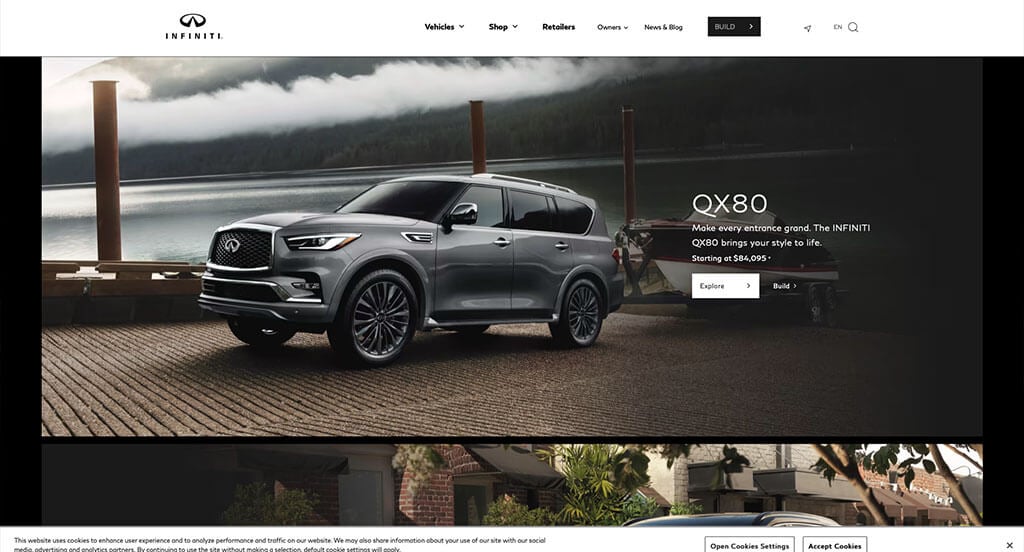
We appreciated how this auto dealer website used the colors of black, white, gray and dark blue to create a custom web design. Of all the custom auto dealer websites we reviewed, one of the features in this custom website we liked was their use of lots of imagery. The large text for their titles was another unique quality in this professional auto dealer site we enjoyed. Infiniti had internet marketing in mind when creating the use of buttons to enhance usability in their website. So many attractive qualities to consider when ranking this website.
25. Rolls-Royce
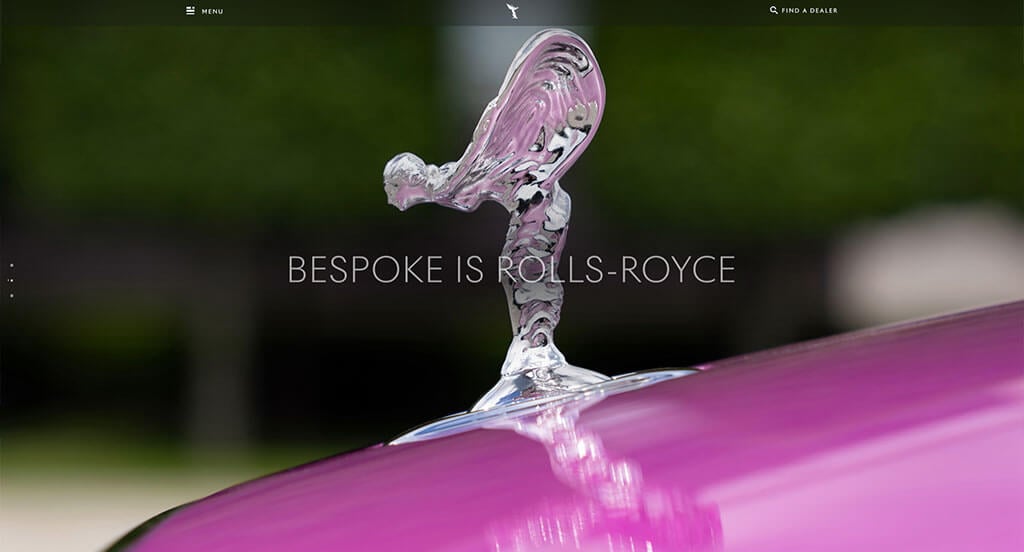
This is a good example of a website design for auto dealers looking for a professional layout. After scrolling past the navigation of this auto dealer site, you’ll notice automatically playing videos for their homepage. Their stunning imagery was another unique quality in this custom auto dealer site we enjoyed. Their clearly labeled menu helped make this one of the top auto dealer websites we reviewed. Talk about a great website to have included in this list of top websites!
26. Byers Auto
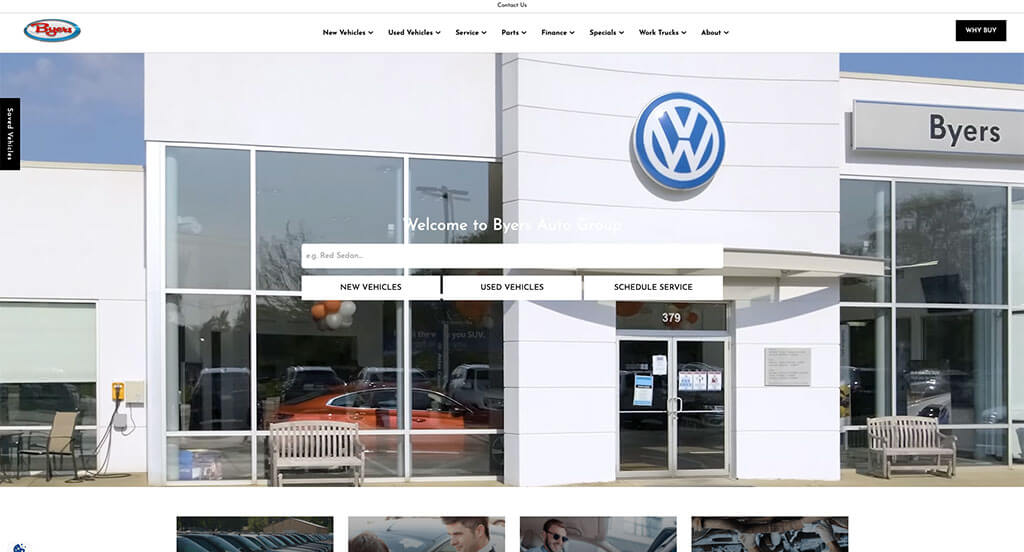
This is a great web design example for auto dealers who are looking for a professional layout. Our web designers thought this website was a good example for auto dealers because of their professional text. The display of all their offered brands was another reason why we included this website in our list of the best website ideas for auto dealers. Byers Auto clearly had a focus on ease of use when creating the search bar for their website. If you are looking for template options for your next auto dealer site, give some thought to this one.
27. SEGREX
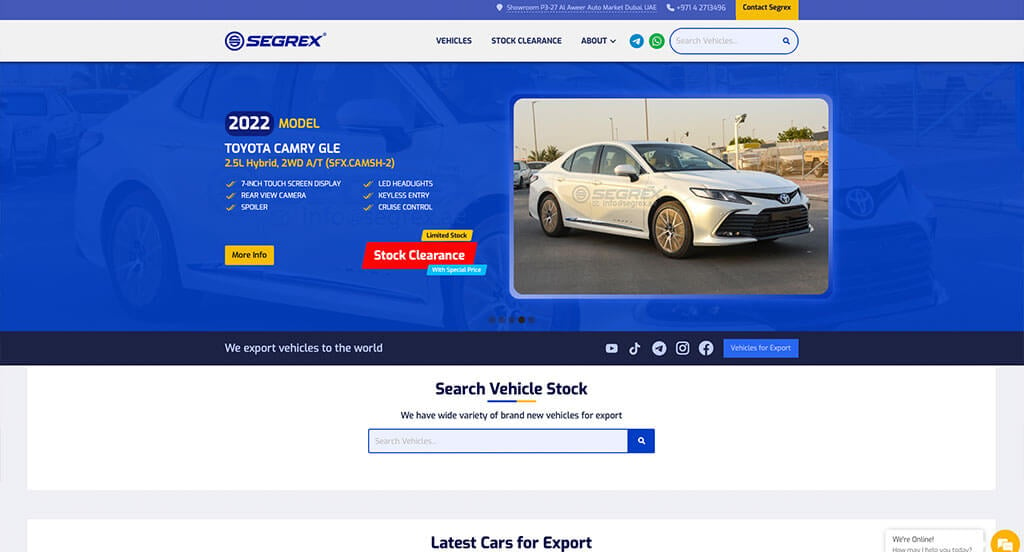
We appreciated how this auto dealer site used the colors of white, blue and yellow to create an attractive website layout. After scrolling past the navigation of this auto dealer site, you’ll immediately notice their variety of information on each vehicle. Another thoughtful feature in this custom auto dealer website was the professional font. SEGREX had internet marketing in mind when designing the use of a search bar for their website. Be sure to consider the creative design of this auto dealer website when developing your next website.
28. Virginia Auto Trader Company
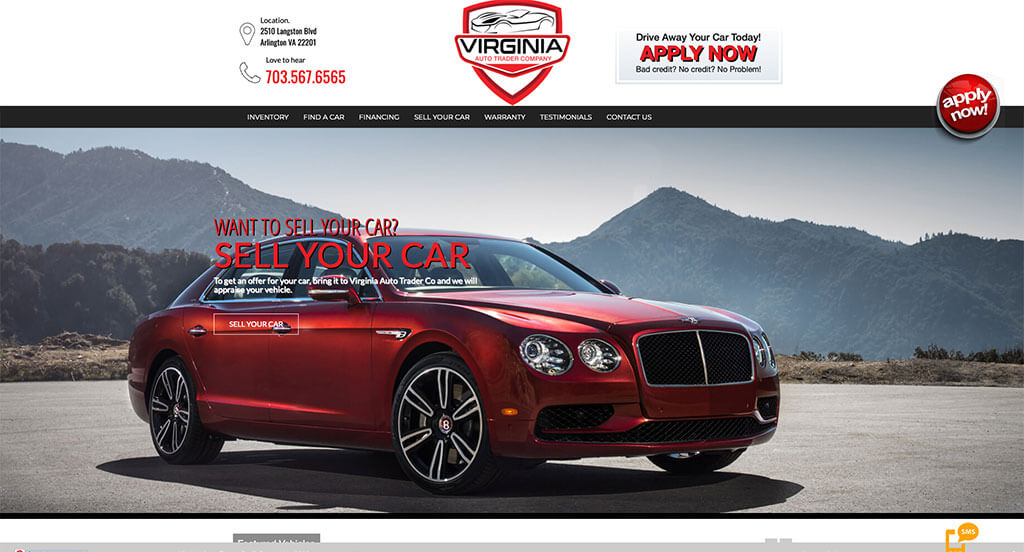
The white, red and black color palette used in this auto dealer site stood out to us because it catches the eyes of viewers. After scrolling past the navigation of this auto dealer site, you’ll notice their interesting transitions for their images. The creative logo design was a nice touch for a professional site. The featured vehicles section helped make this one of the top auto dealer websites we considered. With so many quality reasons to consider this auto dealer website, it’s no wonder we included it in this list of the best sites!
29. Anderson Lincoln
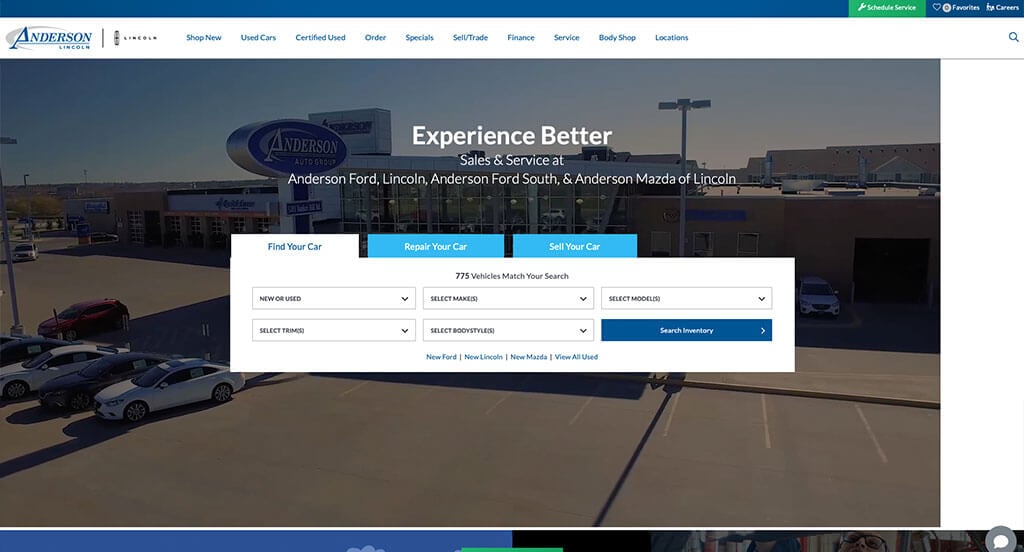
This is a good example of a website design for auto dealers looking for a professional website design. The variety of blue colors used throughout the site was probably the most impactful quality in the homepage of this website. The different sized fonts working in unison to create a stunning look was another thoughtful feature in this professional auto dealer website we enjoyed. They clearly had website accessibility in mind when creating the clearly labeled menu for their website. Give some thought to the one-of-a-kind design of this auto dealer website when developing your next website.
30. Ricart Automotive
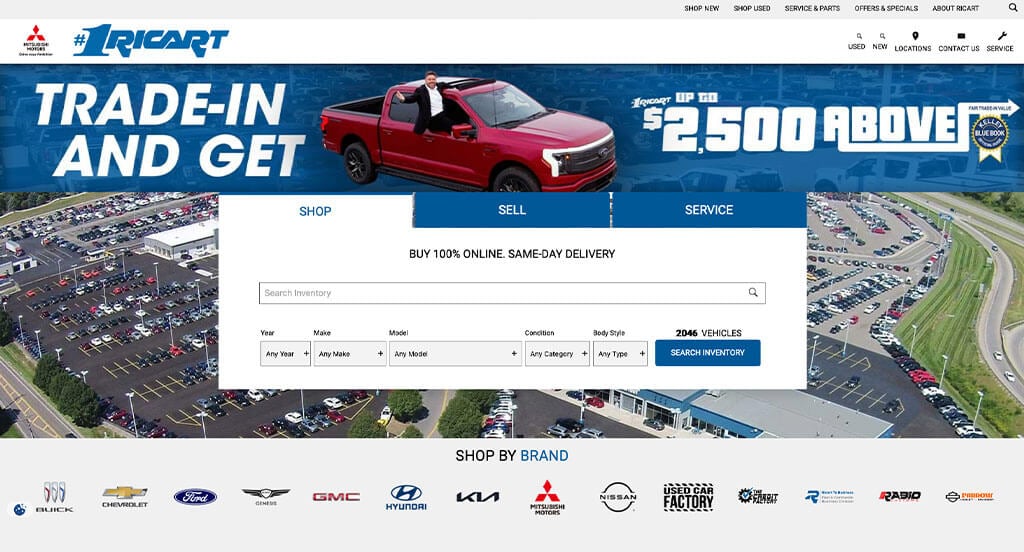
This is a great website design example for auto dealers who are looking for a custom website. We thought this was a good homepage design example for auto dealers because of the template that was well organized. The use of maps to show off their locations was another feature in this custom auto dealer site we enjoyed. Ricart Automotive had ease of use in mind when creating the search bar for their website. What a great website to review when designing your next auto dealer website!
31. Regency Toyota
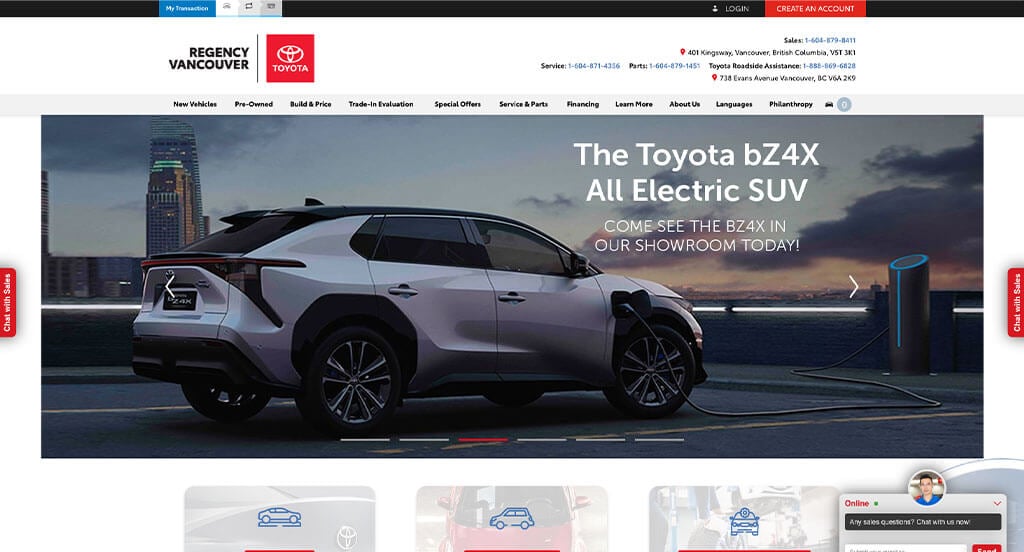
There were numerous auto dealers to choose from, but the website for Regency Toyota was the perfect example of a well-designed website with a white, red and blue color scheme. One of the homepage features of Regency Toyota we noticed was the use of circle frames for their images. Brightly colored buttons were absolutely a consideration when ranking Regency Toyota in this list of the best auto dealer websites. Regency Toyota clearly had a focus on internet marketing when creating the well labeled navigation bar for their website. There was no shortage of reasons to include this website in our list of websites for auto dealers to consider when designing their next website.
32. Land Rover Tampa
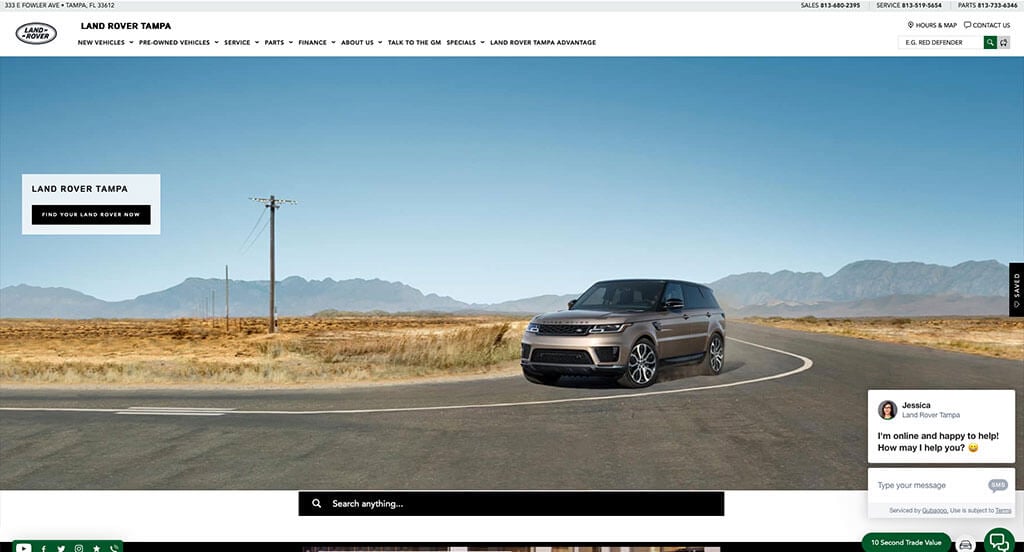
The Land Rover Tampa website has a very classy feel to it, thanks to its unique use of black, white and gray. Our web designers thought this website was a good example for auto dealers because of their high quality visuals. Their use of graphics in the form of icons was another design quality in this professional auto dealer website we enjoyed. They clearly had a focus on digital marketing when building the short and to the point paragraphs for their website. Don’t forget to check this website out while looking through our list of the best auto dealer website layouts!
33. Volvo Cars Manhattan
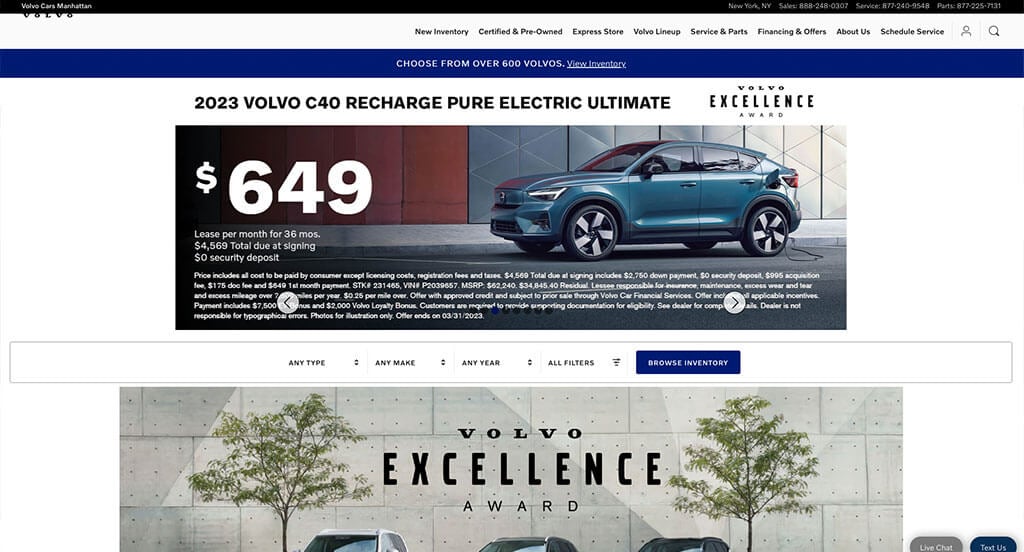
This is a good example of a website design for auto dealers who are looking for a professional website. Of all the custom auto dealer websites we reviewed, one of the features in this custom website we liked was their variety of imagery. The new inventory page was absolutely a consideration when ranking Volvo Cars Manhattan in this list of the most professional auto dealer websites. They had website usability in mind when designing the domain for their website that matches their company’s name. If you are looking for template examples for your next auto dealer site, be sure to check this one out.
34. Pierre Ford
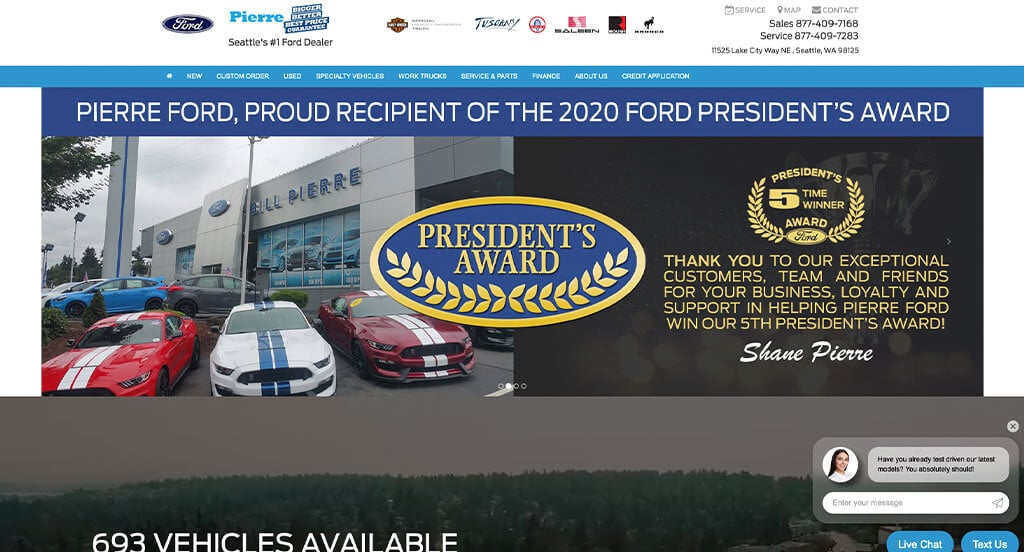
Showcasing a clean and intuitive layout, this site keeps things simple for an auto dealer website. One of the design features we liked most on the homepage of Pierre Ford was their display of their company’s awards because it was rather refreshing for an auto dealer website. The use of an interactive chat was definitely refreshing for a unique site. They clearly had conversions in mind when building the ability to Kelley Blue Book value your vehicle within their website. Be sure to consider the one-of-a-kind design of this auto dealer website when developing your next website.
35. Adamson Motors
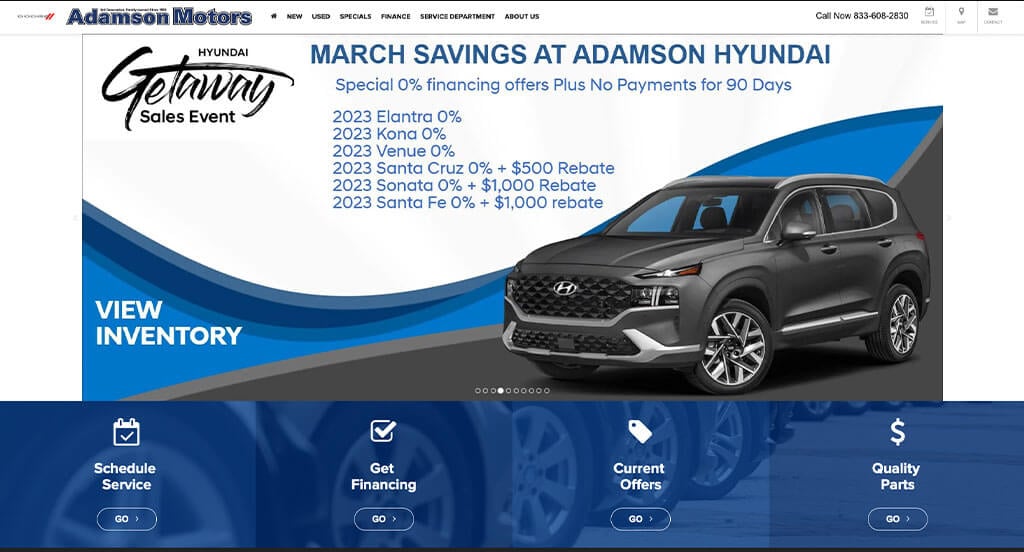
The website of Adamson Motors ranked because it’s one of the nicer auto dealer websites we reviewed. We thought this website was a good design idea for auto dealers because of their layout that was free of distractions. This creative auto dealer site also does a good job with their advertisement of sales on certain vehicles. Adamson Motors had ease of use in mind when creating the well-labeled navigation bar for their website. Don’t scroll past this website when hunting for design ideas for your next auto dealer website!
Related: For improved website traffic, plan out automotive digital marketing campaigns right away.
36. Lexus of Las Vegas
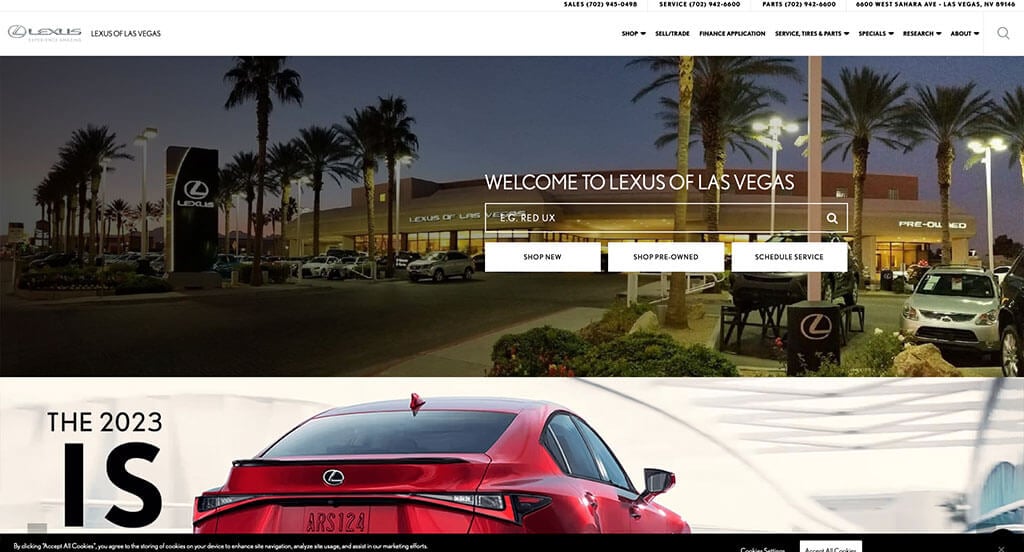
This is a great web design example for auto dealers who are looking for a professional layout. The stunning imagery was definitely the most impactful quality in the homepage of this website. Another design quality in this professional auto dealer site we enjoyed was their specials page. They clearly had website usability in mind when creating the domain for their website that matches their company’s name. You won’t be disappointed after reviewing this website for design ideas for your next website!
37. CarGurus
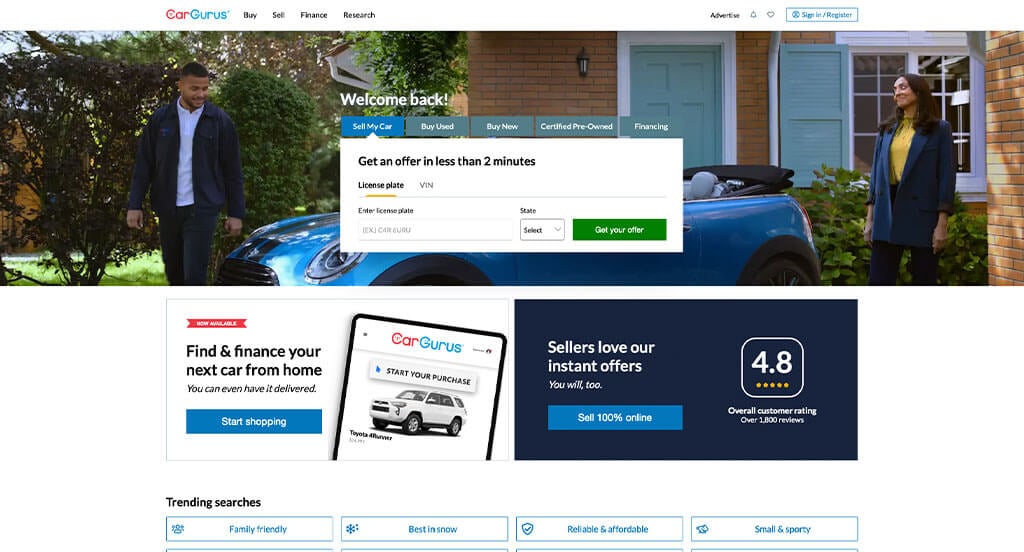
This is a great website design example for auto dealers who are looking for a custom look and feel for their next site. One of the homepage features of CarGurus we noticed was their interesting logo design because it was rather refreshing for an auto dealer website. Their helpful search bar was definitely refreshing for a custom auto dealer website. CarGurus clearly had a focus on website accessibility when creating the simple navigation for their website. For auto dealers looking for examples for their next website layout, this example will for sure be one to keep in your back pocket.
38. Murray Motors
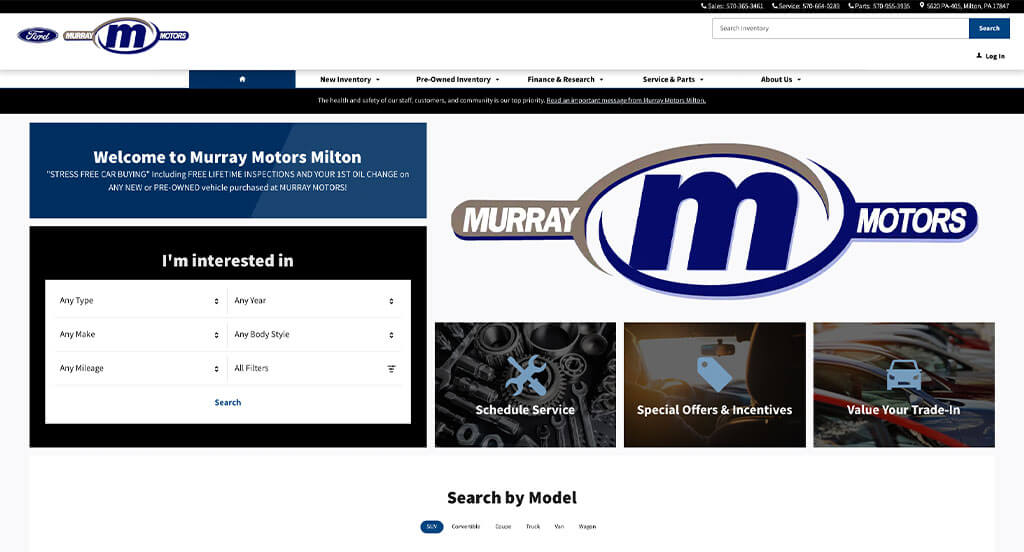
For an auto dealer website, they did a great job utilizing white, gray and blue colors throughout their site. Our web designers thought this website was a good example for auto dealers because of the bold fonts for their titles. Another thoughtful quality in this custom auto dealer site was their short and to the point paragraphs. They clearly had a focus on ease of use when designing the simple contact information for their website. Give some thought to the great design of this auto dealer website when developing your next custom website.
WordPress Auto Themes
You can find free themes at wordpress.org or explore auto-inspired templates at ThemeForest.
Autozone – Themeforest
$76
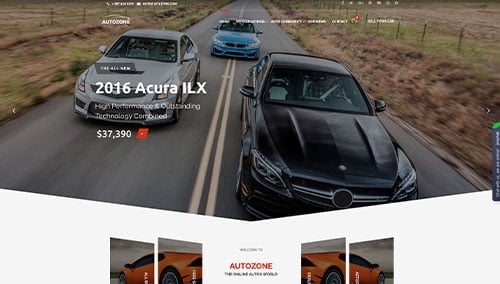
Vrooom – Themeforest
$59
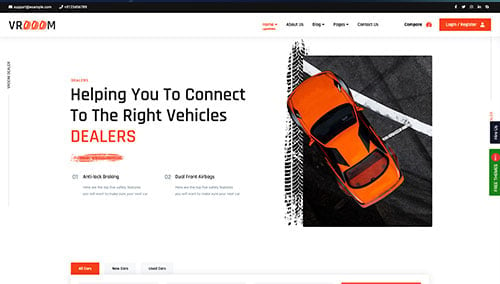
Auto CarForYou – Themeforest
$89
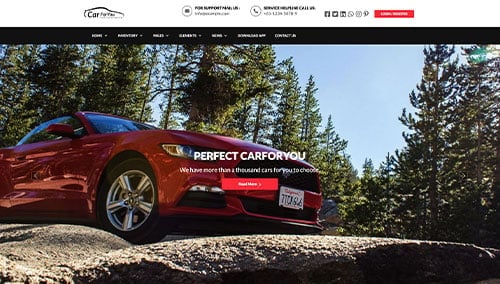
Harrier – Themeforest
$49
